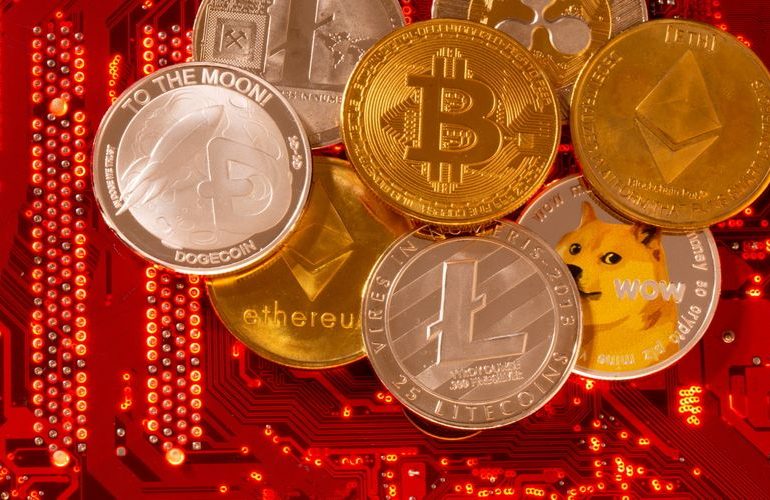The cryptocurrency market has been ultra-volatile and full of twists and turns in 2021, a year that has also seen an explosion in the adoption of cryptos as an investment by both individuals and institutions.
Bitcoin remains undeniably the most important cryptocurrency with its capitalization representing more than 40% of the market. However, Bitcoin was far from the best-performing crypto of the year, as several secondary cryptocurrencies, sometimes called altcoins, outshined the queen of cryptos in terms of 2021 performance despite in some cases being much newer than BTC.
In this article, we’ll highlight 5 cryptocurrencies other than Bitcoin to keep on your radar for the next year. We have excluded less serious coins and crypto memes from the article to instead focus on solid, proven projects that may have real value, while still having considerable room for improvement in 2022.
Ethereum: ETH 2.0 launch could change everything
Although it is often criticized for its network congestion which results in slow transfer times and/or prohibitive fees, Ethereum is hard to ignore. It is the second largest cryptocurrency on the market, just behind Bitcoin. But most importantly, Ethereum remains the preferred network for many crypto projects. Indeed, whether in DeFi or NFTs, ETH is often the platform of choice. For example, more than 90% of NFT transactions take place on the Ethereum blockchain.
In addition, the year 2022 should see a major update to Ethereum, namely Ethereum 2.0, which will solve the biggest problem facing Ethereum, the transaction speed. ETH 2.0 will increase the network capacity from approximately 30 transactions per second to 100,000, mainly thanks to the switch to the “proof-of-stake” validation method, which eliminates the tedious validation method involving complex calculations. This also significantly reduces the energy consumption of the network, a key point as investors around the world are now concerned about the environmental impact of their investments.
Decentraland: The ideal crypto to bet on the metaverse
Meta Platforms (NASDAQ:FB), formerly known as Facebook, launched a new strategy focused on the creation of a metaverse. This shone a spotlight on several cryptocurrencies that did not wait for Mark Zuckerberg to put the concept into practice. One of the most important of these is undoubtedly Decentraland (MANA), which is a fully functional metaverse, where one can buy properties, and participate in games or other online experiences.
MANA, the cryptocurrency used in the Decentraland metaverse, posted a meteoric rise following Facebook’s announcements, and then gave up much of its gains in the subsequent cryptocurrency correction. Once the dust settles, however, the interest of investors in the metaverse will probably endure and even be reinforced, and Decentraland is likely to be one of the best cryptocurrencies to take advantage of the phenomenon.
Solana: Ethereum’s most serious competitor
The shortcomings of the Ethereum network we discussed above have given rise to a specific class of cryptocurrencies that display a similar value proposition to Ethereum, while correcting several of ETH’s major flaws. Solana (SOL) is often mentioned as the strongest and most serious challenger to Ethereum.
Solana emphasizes its massive transaction processing capacity. At this time, Ethereum can only process a few dozen transactions per second, and although ETH 2.0 will eventually remedy this problem, Solana presents an immediate alternative that is particularly efficient, as the network is capable of processing 50,000 transactions per second.
Solana is also an unexpected candidate in the fight for NFT market share, and is proving to be a strong opponent for Ethereum. For the launch of NFT Solana Degenerate Apes Academy in August, 10,000 tokens were sold in just a few minutes. This event allowed Solana to make a name for itself. More importantly, it has allowed Solana to start slowly taking market share from Ethereum.
IOTA: Crypto specializing in IoT and partner of Dell
Unlike the 3 cryptocurrencies mentioned previously in this article, IOTA has rarely made headlines in the trade press this year. IOTA offers a data security service for IoT (Internet of Things) devices, meaning electronic objects connected to the Internet, such as smart speakers or surveillance cameras. This field is set to explode in the coming years, especially with the opportunities opened up by the speed of 5G mobile networks, which are expected to be fully deployed in 2022.
IOTA received support from Dell Technologies (NYSE:DELL) earlier this year, as the computer giant entered into a partnership with the crypto project. Known as Project Alvarium, this partnership will focus on measuring the trust of data before it is used by an application. But beyond the project itself, the fact that a well-known international company like Dell is working with the IOTA network is a good reason to take the cryptocurrency seriously and watch it closely in 2022.
Polkadot: Allows blockchains to communicate with each other
Cryptocurrencies and tokens, and the blockchains they rely on, are more and more numerous in all fields. Even if all blockchains are based more or less on the same basic principles, they are still not able to “communicate” with each other. Polkadot (DOT), created by one of the co-founders of Ethereum, proposes a solution to remedy this problem.
Polkadot comprises a main network – the relay chain – and parachains that operate in parallel, acting as bridges by connecting to other blockchains. With blockchain technology being used far beyond the cryptocurrency market (for example in supply chain management), and being called to generalize in several sectors, the needs of communication between public blockchains, or between the private blockchains of several companies should explode. This should logically largely benefit Polkadot, although there are other cryptos that also meet this need.
Leave a comment

